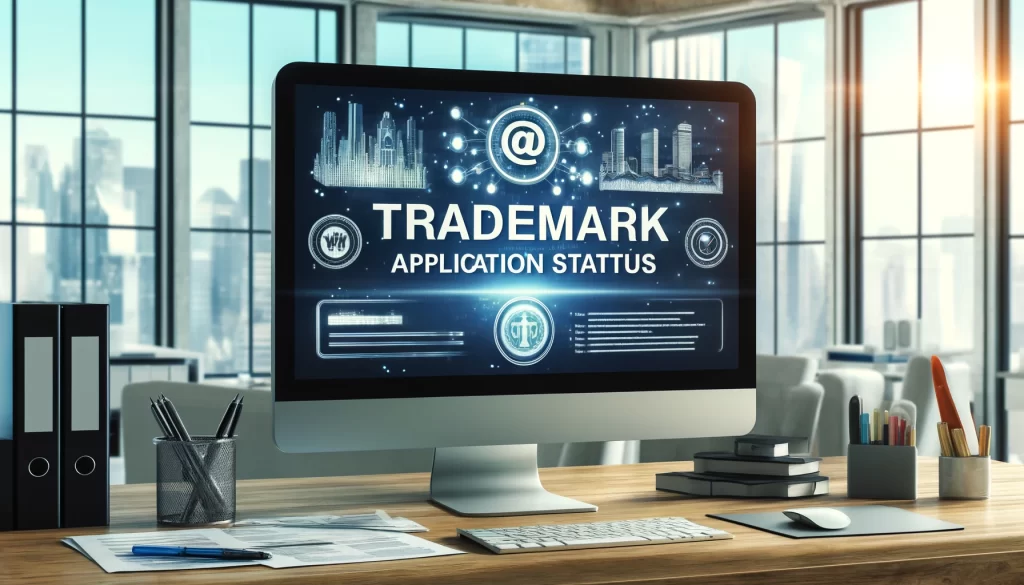Since it is a long process to get a trademark, monitoring the Trademark Application Status of your application and all trademark applicant status becomes sane as you can check many details about which stage it is in. This process, which is handled by the trademark office in your jurisdiction of interest, involves a number of important steps to make sure that you do not unwittingly infringe on an existing mark. After the submission, it is initially examined for any clerical errors, like a lack of data or wrong fees. Once approved, it’s reviewed in much more detail (including a search for conflicts with existing trademarks and an evaluation of whether the mark is not registrable under other trademark laws). This stage is important because usually the examiner will raise queries, which necessitate explanations or additional papers from the applicant.
About Trademark

| Aspect | Description |
|---|---|
| Definition | A trademark is a sign capable of distinguishing the goods or services of one enterprise from those of other enterprises. Trademarks are protected by intellectual property rights. |
| Types | – Conventional trademarks: Include names, words, logos, symbols, and designs. |
| – Non-conventional trademarks: May involve color, smell, or sound. | |
| Purpose | To identify the source of goods or services, assure consumers of consistent quality, and prevent consumer confusion. |
| Rights Conferred | Trademark registration grants the owner exclusive rights to use the mark for the registered goods and services, and to authorize others to use it in return for payment. |
| Legal Protection | Trademark owners can enforce their rights through courts, which can issue orders to prevent unauthorized use of the trademark, known as trademark infringement. |
| Registration Process | – Application: Submitting a detailed application usually specifying the classes of goods or services. |
| – Examination: Assessment by a trademark office for any conflicts or objections. | |
| – Publication and Opposition: Public listing allowing third parties to oppose the registration if they believe it infringes on their rights. | |
| – Registration: Final approval and entry into the trademark register if there are no successful oppositions. | |
| Duration | Trademarks are typically protected as long as they are in use and renewed periodically, with terms varying by country (commonly every 10 years). |
A trademark, trade mark [1], or trade mark [2] is a recognizable sign, design, or expression that identifies products or services of an identifiable source from those of others. A trademark can be anything from a word, phrase, or logo to even sounds and colors. There are also a variety of non-traditional trademarks that make up marks not conforming to these typical forms, other than those based solely on color or sound.
A brand was originally intended to prevent consumers from being confused as to who supplied a product or service. A trademark registration gives its owner the exclusive right to use it as an identifier of goods or services or safely shell out that user for her payment. Courts can prohibit trademark infringement through the implementation of laws that protect trademarks.
Also Check – Mgnregs Payment Status With Aadhaar Number
Types of Trademarks
Trademarks can be classified into several types based on their nature and the elements they include. Understanding these types helps businesses and individuals choose the most effective way to protect their brand identity. Here are the main types of trademarks:
- Word Marks: Word marks are your standard text trademarks with no design elements. They only contain words, letters/numbers or both. Some are like brand “Nike” while some literally sound names such as “Coca-Cola”. Word marks are the most familiar types of trademarks, as they directly cover the brand name.
- Logos and Symbols – These are most often comprised of stylized designs, symbols or logos that represent a business or product. They can be in the symbolist mode, or they might be figurative. Logos and symbols are great for visual marketing, as they can be spotted without reading or understanding any sort of text (like the McDonald’s golden arches example), like Apple.
- Combined Marks – Figurative marks with word elements These can range from having the company name included in a logo or design element that goes with the text. So here is a specific trademark that you can use if you want to build your unique brand. Like what the Starbucks logo does by integrating text and a siren image.
- Trade Dress: This covers the overall look (aka design and image) of a product. For all those products are shape marks, a major factor in their recognition (to the extent they can) being because of its shape; for example the Coca-Cola bottle.
- Color Marks: This type is less typical and covers colors that are applied in a specific manner or combination of colors. A classic case in point is the particular shade of blue used by Tiffany & Co. for their packaging and branding efforts; it has been trademarked by the Company fairly recently.
- Sound Marks – These are trademarks that protect the special sound of a brand. In conclusion, for any sound trademarks to be able to pass the U.s standard they must not only distinctive but also have a recognizable mark such as those of bong from Intel or like lion roar on MGM land.
- Scent Marks: Uncommon as that would be nearly impossible to register since it is personally unimaginable to graphically depict a scent, registers the exact fragrance of your good. For example, Play-Doh has a trademark on its smell.
- Motion Marks: A newer type of trademark, motion marks cover any movement or animation that is used to represent a brand. An example of such detail is the Nokia hands animation when you turn one of their devices ON.
- Taste Marks: This would be few and far between, an almost impossible registration but it would protect the taste of a product. The hard part is describing the taste in a way that doesn’t include your prejudice.
- Position Marks: These keep a check on the exact location where a mark is placed in relation to an article. The most famous example would be the positioning of Adidas three stripes in their footwear and garments.
Each type of trademark serves a specific purpose in brand protection, and the choice depends on what aspect of the brand the business intends to protect most vigorously. The registration process, requirements, and legal protection can vary significantly across these types, making it essential for trademark applicants to understand their differences thoroughly.
Legal Framework for Trademark Protection
The legal framework for trademark protection encompasses national and international laws that establish the rules and procedures for registering and enforcing trademarks. This framework is designed to protect the intellectual property rights of trademark owners, ensuring they can exclusively use their trademarks to identify their goods or services and prevent others from using similar marks that could cause confusion. Here’s an overview:
National Laws
- Acts and Regulations: Each country has its own trademark rights, registration details, and methods of enforcement set out in its statutes. In the USA, operating is vastly different; here, we have what is known as a federal system of government and operate under the Lanham Act (which deals with trademarks at the national level).
- Each country has a trademark office, such as the USPTO (United States Patent and Trademark Office) or EUIPO (European Union Intellectual Property Office). Such offices review applications, grant or register trademarks, and publicize the existence of them.
- The Judicial System handles trademark disputes or infringements through national courts. Judicial enforcement of trademark rights can be an effective remedy to prevent irregular uses, including injunctions against the infringer (as well as his clients and suppliers) awarding damages in case anyone suffers from a loss emanating from irregular use, etc.; destruction or disposing of products found to be pirated.
- Common Law Rights: In some countries, like the United States, trademark rights can be established through actual use in commerce even if they are not registered. This common law trademark right is limited to use within a number of geographic areas.
International Laws
- The Paris Convention was one of the earliest and forerunners of multilateral treaties with respect to intellectual property, including trademarks. It outlined the rules for national treatment and priority rights for trademark applications.
- Madrid Protocol: trademark owners can use the Madrid Protocol to register their marks in any of the countries that have signed onto this treaty by just filing a single application with its national Trademark Office.
- The TRIPS Agreement (Trade-Related Aspects of Intellectual Property Rights), administered by the World Trade Organization, ensures that inventors and designers are formed around their intellectual property. It contains detailed provisions on the protection and enforcement of rights in a trademark.
- European Union Trade Mark (EUTM): Allows for a single registration procedure, which means you pay once to register the mark in all member states of the European Union and thereby get uniform protection along with easier administration.
Post-Registration Considerations
After successfully registering a trademark, the trademark owner’s responsibilities don’t end. Post-registration, there are several considerations and actions necessary to maintain and enforce the trademark effectively. Here’s an overview of key post-registration considerations:
1. Trademark Renewal
Renew at the Right Time: You know well that trademark marks are granted for specific terms, which are 10 years, and should be filed for renewal. Non-renewal of a trademark will result in cancellation and loss of the right to protection.
Process of Renewal: This process generally involves the submission of a renewal application along with the prescribed fees to the relevant trademark office prior to the due date.
2. Monitoring for Infringement
Vigilance: Trademark owners must keep their eyes and ears open in order to protect the sanctity around them, as such actions may dilute or erode the equity of brands or, even worse, mislead customers.
Watching Services: Many companies offer trademark watch services in which the company watches hundreds of databases and the market for potential infringements or new applications.
3. Enforcement of rights
The usual: Once infringement is discovered, trademark owners typically begin by serving the infringer with a cease-and-desist letter requesting that they immediately stop using the unauthorized mark.
Beating Legal Action: If the infringer does not refrain, trademark owners may have to resort to legal action (i.e., suing for monetary damages and seeking injunctions).
4. Maintaining the trademark
Proper Usage: A trademark may lose its enforceability if it is not utilized in commerce. Lack of use over a long period of time can result in claims that the work has been abandoned.
Quality Control: Delivering goods or services within the quality norms of the trademarked goods or services is very important, as otherwise poor products or services can stain a high-value brand.
5. Record of Changes
Changes of Ownership: It is necessary to register any change in ownership, like mergers, acquisitions, and transfers, with the trademark office.
Changes to the Mark: Similarly, if anything material about a mark or the goods or services being protected changes after registration, an updated record is necessary.
6. International Considerations
Global Expansion: If a trademark owner is looking to expand its reach internationally, they should consider securing the registration of their mark in those new countries or regions that they want to do business in as soon as possible under systems like the Madrid Protocol.
Compliance with Jurisdictional Requirements: Each jurisdiction may have additional compliance or national renewal mechanisms to observe in order to keep your trademark protected internationally.
7. Licensing and franchising
Agreements: When licensing or franchising the trademark, correct agreements should be made to help clear payment of use and standards on how to keep up with the integrity of a good-functioning company.
Controlled Use by Licensees: It is important to regularly monitor the manner in which licensees are using the trademark so as to ascertain that they meet agreed standards.
Document Required
| Scenario | Required Documents |
|---|---|
| Employment | – Resume/CV – Identification Documents (e.g., Passport, National ID) – Work Permits (if applicable) – Educational Certificates – References and Letters of Recommendation |
| Opening a Bank Account | – Identification Document (e.g., Passport, Driver’s License) – Proof of Address (e.g., Utility Bill, Lease Agreement) – Social Security Number or Tax Identification Number |
| University Admission | – High School Diploma or Equivalent – Transcripts – Standardized Test Scores (e.g., SAT, ACT) – Recommendation Letters – Personal Statement |
| Real Estate Purchase | – Proof of Identity – Proof of Income (e.g., Pay Slips, Bank Statements) – Credit Report – Property Title Deed – Purchase Agreement |
| Travel (International) | – Passport – Visa (if required) – Travel Insurance – Proof of Accommodation – Itinerary Details |
| Car Rental | – Driver’s License – Credit Card – Proof of Insurance – Booking Confirmation – Personal Identification |
| Medical Consultation | – Health Insurance Card – Identification Document – Medical History Records – List of Current Medications – Referral from General Practitioner (if applicable) |
This table serves as a guideline for the primary documents typically required in various common scenarios. It’s always best to confirm specific requirements with the relevant authorities or institutions as they can vary by location and specific circumstances.
Also Check – Pfms Know Your Payment By Aadhaar Number
Check Trademark Application Status 2024 Check Online at ipindia.gov.in
To check the status of a trademark application in 2024 online at ipindia.gov.in, you can follow these step-by-step instructions:
- Visit the official website of the Intellectual Property India, which is ipindia.gov.in.
- Navigate to the ‘Trademark‘ section available on the homepage.
- Within the ‘Trademark’ menu, find and click on the option labeled ‘Related Links.’ From the dropdown, select ‘Public Search.’
- Once you are on the Public Search page, select the ‘Trademark Application/Registered Mark’ option.
- Enter the application number of the trademark you wish to check in the provided field. Ensure you have the correct application number as input mistakes can lead to errors in retrieving the correct information.
- Choose the appropriate class of the trademark from the drop-down menu. The classification is based on the nature of the goods or services your trademark represents.
- Click on ‘View’ to proceed with the search.
- The system will display the status of your trademark application. The status may vary, showing terms like ‘New Application’, ‘Formalities Chk Pass‘, ‘Marked for Exam‘, ‘Objected‘, ‘Advertised before acc’, ‘Registered’, etc., each indicating a specific stage in the application process.
It’s advisable to regularly check the status of your trademark application to promptly address any queries or objections raised by the trademark office, ensuring a smoother registration process.
Conclusion
Trademark application status is an important learning source that tells you where your trademark application stands at various stages of the registration process. Checking the status regularly is important for applicants because it enables them to react in time to requirements, oppositions, and objections. And when it comes to planning the strategic exploitation of a trade mark in business operations, it helps you make sure all legal protections are properly sought and preserved.
Trademark Application Status Contact Details
| Contact Method | Details | Availability |
|---|---|---|
| Phone | +1 800 123 4567 | Monday – Friday, 9 AM – 5 PM EST |
| [email protected] | 24/7 (Responses within 24 hours) | |
| Online Chat | Access via ipindia.gov.in | Monday – Friday, 9 AM – 8 PM EST |
| Physical Address | 123 Trademark Ave, IP City, IP State, 12345 | Office visits by appointment only |
| Fax | +1 800 765 4321 | Available 24/7 |
| Contact Form | Submit through website: ipindia.gov.in/contact-us | Available 24/7 |

Vikas Gupta is an insightful content creator and financial analyst, educated in economics and public administration. At yojanastatuschecktoday.in, he specializes in simplifying complex government schemes, aiming to empower readers with vital information. His expertise helps citizens navigate and utilize government initiatives effectively, ensuring access to essential updates and developments.
